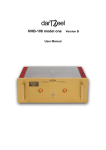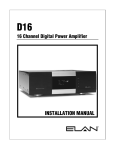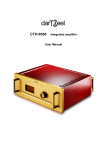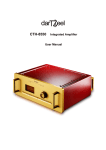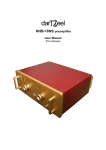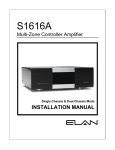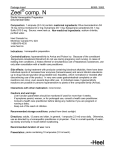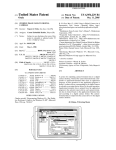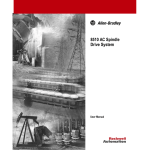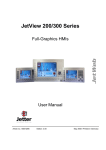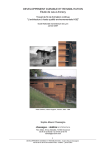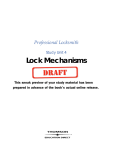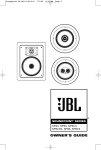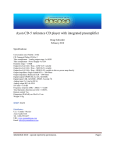Download User manual
Transcript
darTZeel NHB-108 model one
Audiophile's technical manual
darTZeel NHB-108 model one
Audiophile's technical manual
Page 2 of 28
TABLE OF CONTENTS
1.
2.
3.
4.
5.
6.
7.
8.
9.
10.
11.
12.
Introduction ................................................................................................................................................... 5
Genesis of NHB-108 ..................................................................................................................................... 5
Criteria........................................................................................................................................................... 6
Structural aspects........................................................................................................................................... 6
4.1.
The case modules ............................................................................................................................ 7
4.2.
Divide to conquer............................................................................................................................ 7
4.3.
Eliminating vibrations ..................................................................................................................... 7
4.4.
Everything is transparent................................................................................................................. 8
4.5.
TIO, Totally Identified Object......................................................................................................... 8
The audio electronics..................................................................................................................................... 9
5.1.
What is distortion? .......................................................................................................................... 9
5.1.1. Keeping in harmony ............................................................................................................ 9
5.1.2. Inter Modulation Distortion............................................................................................... 10
5.1.3. Temporal Distortion .......................................................................................................... 11
5.2.
What application field? ................................................................................................................. 11
5.2.1. IGBTs................................................................................................................................ 12
5.2.2. FETs .................................................................................................................................. 12
5.2.3. Bipolars ............................................................................................................................. 13
5.3.
The circuit of darTZeel ................................................................................................................ 13
5.3.1. Criteria of choice ............................................................................................................... 13
5.3.2. darTZeel schematics ........................................................................................................ 13
5.3.3. Component layout ............................................................................................................. 14
5.4.
Symmetrically balanced? .............................................................................................................. 14
5.4.1. From the microphone… .................................................................................................... 15
5.4.2. To the loudspeakers…....................................................................................................... 15
5.4.3. And into the air….............................................................................................................. 15
5.4.4. Via the darTZeel .............................................................................................................. 16
5.5.
darT to Zeel 50Ω......................................................................................................................... 17
Onboard safety............................................................................................................................................. 18
6.1.
Crowbar circuit.............................................................................................................................. 18
6.1.1. Crowbar activation ............................................................................................................ 19
6.1.2. Crowbar cycle ................................................................................................................... 19
6.2.
Supervision system........................................................................................................................ 20
6.2.1. Current sensing.................................................................................................................. 20
6.2.2. For its eyes only ................................................................................................................ 20
Power supplies............................................................................................................................................. 20
7.1.
From mains to loudspeakers.......................................................................................................... 21
7.2.
Voltage or current?........................................................................................................................ 21
7.3.
Received idea ................................................................................................................................ 22
The sound of darTZeel ............................................................................................................................... 23
Reliability .................................................................................................................................................... 23
9.1.
Quantified longevity...................................................................................................................... 23
9.2.
Long term availability ................................................................................................................... 24
9.2.1. Spare parts ......................................................................................................................... 24
9.2.2. Self-preservation instinct................................................................................................... 24
The next darTZeel ................................................................................................................................. 25
Keeping an open door ............................................................................................................................. 26
Special adjustments ................................................................................................................................ 26
12.1.
Output DC voltage drift................................................................................................................. 27
12.2.
Monitoring circuit ......................................................................................................................... 28
12.3.
Version B ...................................................................................................................................... 28
12.4.
Future developments ..................................................................................................................... 28
darTZeel NHB-108 model one
Audiophile's technical manual
Page 3 of 28
darTZeel NHB-108 model one
Audiophile's technical manual
Page 4 of 28
darTZeel NHB-108 model one
Audiophile's technical manual
1. Introduction
Thank you for studying this manual,
demonstrating proof of your interest in
the darTZeel NHB-108 model one.
First of all, please do not think for a
minute that we consider audiophiles differently from music lovers. We know
perfectly well that audiophiles love music
too, and we are very happy with this.
It is however true that music lovers are
generally less inclined to enjoy the technical and performance side of the music,
hence the existence of the Music lover's
manual.
In the light of what follows, you will better understand why our technical choices
during the design of the darTZeel NHB-108
model one led to what one could call a
truly exceptional machine.
We trust that you will derive great pleasure from reading this manual, and that
we succeed in communicating some of
the burning passion that has been boiling
inside us for more than 25 years.
Enjoy your reading!
2. Genesis of NHB-108
The NHB ("Never Heard Before") project
began in summer 1984.
Crazy about audio since childhood, we
gradually developed the idea of designing a power amplifier.
Even though the NHB-108 model one is the
fruit of a single man, the moral, financial
and professional support from family and
friends over all these years has played a
huge part in this endeavor.
At the time it was only a dream, and we
are grateful to every gal and pal who has
been involved in it and contributed to its
achievement.
darTZeel NHB-108 model one
In the '70s and ‘80s, here in Europe,
Japanese electronics were queens and
kings of the market. Very rare, and
above all virtually unknown, was the real
high-end audio gear coming from USA or
elsewhere. The finish was already very
good, but the sound quality did not come
up to scratch, simply because it was not
one of the original design goals! Only a
few companies were able to offer real
breakthrough products. Not all of them
are still in business, Alas!
The more the years passed, the more
our desire for designing a new machine
became tangible. In mid spring 1984, we
produced a first digital power amplifier in
a school lab, as a diploma project.
Paradoxically, the innovation here was
not the fact that the amp was digital, but
that no feedback whatsoever was used.
The output stage was totally open-loop.
The sonic result was so astounding that
we immediately started the NHB project,
although its code name did not come
until later.
The initial idea was to design a new very
powerful digital amplifier, totally open
loop if possible, with the purest sound
reproduction we could attain, without
any other consideration, especially the
price factor.
The main problem at the time was that
the technology did not yet offer the
monochip solution, so we had to build
the circuit entirely in hybrid technology,
using mainly discrete devices. The odd
thing is that even in this early 21st century, we have still not surpassed the
speed of those old circuits.
Another problem then arose. Our circuits
were much more complex than a single
modern IC, and of course they were not
very reliable either. We especially encountered several performance consistency problems from sample to sample,
and we gave up for a time. Some years
Audiophile's technical manual
Page 5 of 28
later, new ICs allowed further investigation, and we built several prototypes. We
quickly noted, however, that digital had
some limits when pushed hard.
We used a sample frequency of 500 kHz
at the time, corresponding to a theoretical bandwidth close to 250 kHz, far
higher than all competitors, even in the
analog domain. But – alas – even with
such a high sample frequency, the actual
measured bandwidth was strongly dependant on the loudspeaker impedance.
Another problem, jitter, already well
known in labs at the time, was difficult to
cure, to say the least. The signal to noise
ratio was just above our minimum criterion.
Since pure sound was the only goal, then
noise, if at acceptable level, could have
been tolerated by us. On the other hand,
interdependence between load impedance and frequency response was not
our cup of tea. Not by a long chalk.
End of the digital trip.
It is interesting to note that several
manufacturers offer digital amplifiers,
with greater or lesser success. The theoretical limits remain the same, even if
better managed than in the '80s. Analog
fortunately does not have to cope with
such limitations.
After several months of deep thinking,
circuit designing, and circle squaring attempts, the project was revived (in
1990) on brand new bases. The gear
would be fully analog, moderately powerful, and as close as possible, philosophically speaking, to the signal treatment used in its digital ancestor.
Two new prototypes were built on the
basis of existing designs; even though
heavily modified to suit our tastes, they
produced unexciting results. Then we
asked ourselves what is the point of producing nice looking gear if the sonics
bring nothing new under the sun?
In 1992, we decided to develop a revolutionary design from scratch. This ultimate quest (for ultimate sound) lasted
over 5 years, with more disappointment
than joy. But the fun was always here.
tained, in mid 1995, what we could call
the first theoretical design corresponding
to our aims.
From 1995 to 1999, on that first elementary circuit basis, dozens of different
versions were simulated, some of them
being built and listened to.
By 11 November 1999 the definitive circuit was built and assembled. This was
the very first darTZeel machine, the NHB108 model zero.
The results, sonically speaking, were
outstandingly better than expected. It
seems that this design was the right one.
So much so that most of our test listeners said that this product must be put
into production, even on a very small
scale.
The darTZeel NHB-108 model one was born.
3. Criteria
Your darTZeel NHB-108 model one is not an
ordinary machine and this is no doubt
one of the reasons why you purchased it.
The entire concept is based on just three
criteria:
-
Simplicity
Purity
Reliability
These words can often be deceptive.
Easy to pronounce, conjuring up elegance and fascination, they nevertheless
constitute very tough technical challenges, since their respective meanings
are not at all easy to reconcile.
Nothing is eternal. As for the darTZeel
NHB-108 model one, not enough time has
yet elapsed for us to assert such a claim.
What we do assert is that everything has
been taken into account so that you can
benefit from your machine for a long
time. A very long time.
You will discover that more often than
not, simplicity means long lasting.
Sometimes, it also means purity,
whether of sound or of form.
Welcome to darTZeel.
Countless schematics were studied, scrutinized and hooked together until we
obtained, in mid 1995, what we could
darTZeel NHB-108 model one
Audiophile's technical manual
Page 6 of 28
4. Structural aspects
It would be all too easy to compare the
darTZeel NHB-108 model one and wristwatches, both being made in Switzerland. There are no springs, cogwheels, or
hands in a NHB-108 model one. Here, everything is a tad… bigger.
4.1. The case modules
The case of your machine is exclusively
machined from AW-5754-ALMG3 alloy aluminum, offering a remarkably even surface and
hardness.
Every item is CNC machined from the
billet in order to ensure a very high density and outstanding rigidity, thus considerably lowering all unwanted resonances.
The elements are finished in the three
hard anodized darTZeel colors, namely
electric blue, blazing red, and gleaming
yellow. This unique finish gives to the
darTZeel NHB-108 model one its inimitable
appearance.
The three main elementary modules are
the mother plate, the transformer platforms and the heat sinks. They are
tightly assembled together with nonmagnetic, stainless steel screws.
Each basic module is first carefully hand
assembled, and individually tested. Only
then is it dated and signed before being
fitted.
If you dismantle your darTZeel NHB-108
model one, you will see that modules are
not assembled in a hurry. Some of them
are installed with several weeks elapsing
between construction and assembling.
In line with this non-stress approach, we
take all the time necessary to achieve
the best job we can. If our tests show
that a component is out of specification –
this can sometimes occur after its assembling – the entire module is dismantled, checked, and reassembled before
being tested a second time.
The darTZeel NHB-108 model one housing
features a 25mm false bottom, sandwiched between the 6mm thick mother
plate module and the 4mm thick bottom
plate. All cables and wires are routed in
darTZeel NHB-108 model one
this sandwich, minimizing the influence
of electromagnetic fields.
Furthermore, such an arrangement is of
extreme rigidity ensuring exceptionally
good mechanical coupling between the
mother plate and heat sinks modules.
4.2. Divide to conquer
The inside of the darTZeel NHB-108 model
one is divided into four distinct volumes.
The left and right channels are insulated
from each other, as are their respective
power supplies. This unprecedented construction allows extremely low crosstalk
behavior across the whole audio frequency range. You are either true dual
mono, or you are not. The darTZeel NHB108 model one definitely is.
The two front compartments are devoted
to the power supplies, and are themselves divided into a two-storey structure. The Crowbar elements and the soft
start circuitry are located on the lower
level, while the suspended toroidal transformers are fixed on the 6mm thick, upper decks.
We insist on the fact that in the final assembly process, all parts are first carefully aligned before being tightly screwed
together. This additional precaution adds
still more rigidity, and the entire case
then behaves as a single block. As a free
bonus, the case is thus virtually dust
proof.
4.3. Eliminating vibrations
The fastening of the power supply transformers was carefully thought out as regards noise reduction and trouble-free
life. A specially developed suspension
ensures that even in case of failure, the
transformers will not fall off.
So, in 40 or 50 years, when the rubber
absorbers have become – perhaps –
worn out, they will withstand their last
trip to the factory for their replacement.
The same is true for the silentblocs used
for suspending the lighter audio and
monitoring circuits.
These various suspensions, tuned on
different resonance frequencies, are
coupled quite tightly to the chassis, absorbing especially the medium and high
Audiophile's technical manual
Page 7 of 28
frequencies, most important in terms of
sound reproduction accuracy.
And while on this subject, have you ever
heard an amplifier singing? This can occur when the transistors of the final
stages and/or the power transformers
are not properly decoupled.
They start to vibrate at the excitation
signal frequency – in this case the music
– this vibration interfering with the
electrical origin of the signal. You can
hear it if the amp is hooked to a dummy
load, since in normal use, loudspeakers
fortunately mask this disconcerting
internal “singing”.
No such mechanical singing on the
darTZeel NHB-108 model one! The electric
signal is transmitted stage to stage, from
input to output, free from any mechanical disturbance, internal or external.
The darTZeel NHB-108 model one stands on
3 pads incorporating rubber inserts.
Oddly enough, very few manufacturers
rely on 3 legs instead of four. We can
recall that the Lunar Explorer Module
(LEM) also had three legs, but that is
another story after all.
Weighing around 30kg, the darTZeel (not
the LEM) needs to have a good stable
base. Those three pads are evenly located around the horizontal center of
gravity of the amplifier, ensuring excellent stability on virtually any surface.
The absorbing rubber pads dampen the
lower frequencies, thus forming the ideal
complement to the suspensions described earlier. In the case where you
would want to use 2, 3, or even 4
stacked darTZeel NHB-108 model one units,
we have designed special pads of different diameter to maintain the very same
vibrational absorption behavior. These
pads are easy to install and can be purchased separately.
its dust proof quality. Your machine will
therefore remain as new for years to
come.
The reason why we did not choose a
metal cover is not so obvious as it might
appear. It is true that to look through
the glass of the darTZeel NHB-108 model
one is a pleasure for the eyes. Look at
those Moon-crescent shaped bar busses,
and tell us frankly what you feel…
There are also a couple of technical advantages that glass has over metal.
Its crystalline, inert structure, combined
with the rubber foam seal, functions as
an internal noise killer.
And contrary to metal, glass is totally
transparent to magnetic fields, thus
avoiding the inherent magnetic loop that
metal would induce over the power supply transformers. Last but not least, the
internal housing is much less polluted by
magnetic ghosts.
4.5. TIO, Totally Identified Object
It is however the final touch that makes
this darTZeel NHB-108 model one, now installed in your listening room, your
darTZeel NHB-108 model one:
We refer to the identification plate, fully
described in the Owner's manual.
Made from 24k gold plated brass, it is a
unique handmade piece, just like the
machine on to which it is affixed.
Your name is engraved in gold letters,
thus amalgamating the destiny of the
darTZeel NHB-108 model one with your future unforgettable musical moments.
We proudly congratulate you!
4.4. Everything is transparent
The darTZeel NHB-108 model one cover is
made of 8mm thick tempered, bronzesmoked glass. It harmonizes magnificently with the colors of the housing, and
gives an inimitable touch.
The glass is held by a single, central
screw, and rests on a foam rubber seal,
giving to the darTZeel NHB-108 model one
darTZeel NHB-108 model one
Audiophile's technical manual
Page 8 of 28
5. The audio electronics
Simplicity.
The whole darTZeel NHB-108 model one
electronic concept could come down to
this single word.
Simplicity does not mean simple, however.
Purity
Total cancellation or absence of harmonic distortion does not mean "purity",
alas.
You certainly know that most musical
instruments are very rich, harmonically
speaking. Thanks to these harmonics, we
can distinguish between a saxophone
and a flute.
Did you know, though, that the level of
these natural harmonics can easily reach
20 to 40% of the fundamental note, depending on the instrument played? But
do we say that an instrument distorts?
5.1. What is distortion?
In the audio world, any signal change is
called "distortion". A lot of different kinds
of distortion exist, but we mostly speak
about "Total Harmonic Distortion", or
THD. THD is so well known that we more
than often forget that other ones do exist.
Negative Feed-Back, NBF, is a smart
electronic trick used for diminishing or
even eliminating all type of distortions,
and can be roughly described as follows:
At the amplifier input we put a signal
having an inverse deformation from the
one it naturally produces at its output.
So, the new output signal will be "purified" since the 2 inverse deformations
will cancel each other.
This is what the theory says.
Now let us see what actually happens in
practice. We will discuss only the bestknown distortions, given that their behavior is simpler to explain.
5.1.1. Keeping in harmony
Let us take an amplifier especially designed to produce exactly 1% of THD.
darTZeel NHB-108 model one
Then let us feed it with a recorded musical instrument. We shall suppose that
this instrument is moderately rich harmonically, say around 20%.
Now, let’s be a bit optimistic and suppose that the speakers we will use are
truly perfect, without a single trace of
any distortion.
Well, now, let us try figure the THD we
will have at the output of the amplifier.
We could be tempted to say "21%, since
20 plus 1 makes 21, no?"
Okay… So then, which "golden ears"
could notice the THD difference between
20 and 21%? Who could swear that the
amplifier does add distortion?
In fact the distortion change is even less
than this. THD, like most other noncorrelated physical phenomena, does not
increase in a linear fashion. The "total"
THD is equal to the square root of the
sum of the squared individual THDs.
A little equation is even better than a
less-than-clear definition:
THD =
(HD1 )2 + (HD2 )2 + .... + (HDn )2
In our particular case, we only have 2
terms, so the equation becomes:
2
2
20 1
THD = 100
+
= 20.025%
100 100
And now? Who could distinguish between
a 20.000% harmonically rich musical
instrument, and another one producing
20.025%? Not us for sure.
And the very next note, how rich is it?
And the next one? Oh! The song has already finished? What sort of music was
it?...
Even though in reality THD is a bit more
complicated than this, we can still see
that a posteriori, it does not have the
importance that was attached to it for
decades – quite the contrary.
If at darTZeel we could completely eliminate THD while maintaining our 3 main
criteria, then maybe we would do so.
Maybe. Just for the beauty of the gesture.
Audiophile's technical manual
Page 9 of 28
Some amplifiers available on the market
claim extremely low THD figures, at the
very limit of instrumentation measurement, assuming this result necessarily
leads to outstanding sound purity. We
take this with some caution, since it recalls for us the 70-80' Japanese philosophy, by which "performance" implies
"quality". We have to be fair by acknowledging that such designs can be liked
and even loved by audiophiles. The world
is big enough for multi musical tastes.
The idea is very nice indeed, and we do
admire such a philosophical approach,
even if it is not ours: the problem is that
those designs are highly sophisticated –
too much for our ears – involving lots of
added transistors, op amps, and higher
than reasonable NFB, leading finally to
altered sound structure.
These electronics can be considered as
very pure and detailed for the first listening hours or days, but once noticed, their
sonic signature becomes harder and
harder to bear.
So if THD does not seem to be a determinant factor in the accuracy of the reproduced sound, we have to look elsewhere.
5.1.2. Inter Modulation Distortion
Now, let us listen to two flute players.
The flute is well known for its less rich
than usual sound - harmonically speaking, of course! A kind of exception confirming the rule.
If each player produces a different, sustained note, what will we hear? One intermediary note, two distinct notes, or
more than this?
In theory we should hear 2 distinctive
notes. In theory only? Well yes, because
in practice our hearing is not perfect.
Truly wonderful indeed, but less than
perfect.
Without entering into details, we can
nevertheless say that in fact we will not
only hear 2 distinctive sounds, but also
combinations of those primary notes.
We beg musicians and music lovers to
forgive us, but for a while we need to
replace notes by frequencies. Not very
darTZeel NHB-108 model one
musical, but much easier for the purposes of our explanation.
If the first flute plays a 1,000 Hz tone,
and the second one a 2,500 Hz tone, we
will not only hear those two discrete
tones, but also the following combinations:
2,500-1,000=1,500 Hz, also called the
beating frequency, and also the mirroring part, say 2,500+1,000=3,500 Hz.
Fortunately, those combinations are of
much less amplitude than the discrete
notes themselves. But that’s not all! We
will also hear the harmonics of these
combinations! So, frequencies of 1,500,
3,000, 4,500 Hz, but also 3,500, 7,000
and 10,500 Hz will be perceived. Once
again, their level will be very low compared to the 2 initial notes played.
It seems hardly believable, but it is
true… In practice, though, this is far less
embarrassing than you might think at
first glance. As said above, the relative
level of those "ghosts" is much lower
than the basic notes. The result will be
heard as if the flutes had some tremolo,
or vibrating behavior, a very easily perceived phenomenon. And the combination’s harmonics will add some "warming" factor, or on the contrary some
"coldness" or "dryness" to the perceived
sound, depending on how they will combine together.
So you can see that lMD is even less
easy to understand and quantify than
THD. And how can we appreciate IMD,
can we hear it, at what level does it become a nuisance?
Well, the first thing we can admit is that
it is not musical instruments that generate inter modulation effects, but our own
hearing – brain included – that is the
cause. Some acousticians say than our
internal ear can "produce" inter modulation artifacts at levels between 25 to
40%! Of course the brain then does
some necessary "correction".
However, this kind of "correction" cannot
be compared with an electronic chain,
say the microphone and analysis system.
So, we feel very uncomfortable about
advancing any IMD value from external
origin for which our ear is sensitive. In
practice it seems that IMD less than 2%
Audiophile's technical manual
Page 10 of 28
(3 to 5% for THD) is considered as not
disturbing, even not audible in a musical
context, judging by the Single Ended
Triode aficionados or by all the psycho
acoustical experiments conducted over
the past few decades.
By way of conclusion, it appears that
IMD, while perhaps more disturbing than
THD, remains practically harmless, provided the levels are not outrageously
high.
Okay. Now bring on the next suspect…
5.1.3. Temporal Distortion
In the ‘seventies, the famous Matti Otala
highlighted a new kind of distortion, not
so easy to measure, but clearly audible,
called Transient Intermodulation Distortion, TID (also called TIM, for Transient
Inter Modulation).
TID occurs when the negative feedback
(NFB) loop is in a state of overflow,
something that arises more often than
you might think since the NFB correction
always applies after the phenomenon to
be corrected appears. During these very
short instants, the amplifier can produce
more than 100% THD and/or IMD.
At darTZeel, we prefer to call it Temporal
Distortion, or TD, because this is obviously what it actually is. It is one of our
favorite subjects for discussion, since it
is here that we can find the key to the
problem.
Since the CD came on the scene, lots of
water has flowed under bridges. In the
‘nineties, a big bug reared its ugly head
on the "perfect sound for ever" road. Its
name is "Jitter", and it is, more scientifically speaking, an "uncertainty of chronometer precision".
Jitter is nowadays well known, and well
explains why temporal errors, even when
small, lead to amplitude distortion. Effectively, a "0" or a "1" not arriving on time
will be translated into output amplitude
which will not be proportional to the input amplitude of the signal. We all know
how jitter "sounds", when not cured.
Thanks to – or because of – this famous
jitter, a truly digital calamity, we can
better understand that temporal distortion will alter the precious and delicate
darTZeel NHB-108 model one
analog, musical signal. In the analog
world, though, TD is more subtle and
more difficult to treat and cure.
In the darTZeel NHB-108 model one, everything has been done to preserve the
temporal integrity of the music.
There are two principal means for reducing, or even eliminating, TD.
The first is to use several small but local
NFB loops, instead of a bigger and
slower, global NFB loop. This approach
greatly improves signal transfer speed
and propagation delay time.
The second is based on the principle that
temporal error is equivalent to phase
shift. So if one can enlarge the frequency
response by a factor of ten (say 200
kHz), phase shift will be also greatly reduced.
Ideally, the best would be to apply both
means described above. The only problem is that they contradict each other.
High bandwidth generally requires higher
global NFB, while low NFB leads to
poorer frequency response.
Here is where the darTZeel NHB-108 model
one comes in, the first very low NFB and
high bandwidth power amplifier. No
global NFB is used, and both 1st and 3rd
stages are even open loop! So what
about the frequency response? Everything is okay up to the Megahertz range
(1,000,000 Hertz), say fifty times the
audio range!
5.2. What application field?
The electronic schematics of the darTZeel
NHB-108 model one's audio circuit, as we
will soon see, is astonishingly simple.
"It's because the NHB-108 has high THD
and IMD values", would say our wellmeaning detractors.
If you have read us from the beginning,
you are now perfectly aware that harmonics are not directly responsible for
the sonic signature of an amplifier.
The apparent simplicity of our audio circuit has been effectively made possible
through our choice of semiconductors
technology.
Audiophile's technical manual
Page 11 of 28
If the THD and IMD produced by the
amplifier are kept low enough, say lower
than the audibility threshold, then no
further correction will be needed, and
the audio circuit can remain simple.
At the start of this new century, 3 main
technologies coexist in the construction
of transistors, these being in chronological order:
-
Bipolar, in the early 1950s.
Field effect, in 1962.
IGBT, a mix of the previous two, in
the ‘eighties.
At darTZeel, we strongly believe in new
technologies. On the other hand, we
readily admit that nothing can replace
experience.
So, "our" winner is…
Bipolar technology!
5.2.2. FETs
FET stands for "Field Effect Transistor",
of which there are two main categories.
For small signals, they are called as is,
FETs.
For power applications, their most common name is MOSFET, which stands for
"Metal Oxide Silicon Field Effect Transistor". They behave similarly to FETs,
but their internal structure may vary.
FETs are being used more and more, for
several reasons, including the most obvious one:
It is commonly accepted that they perform very closely to vacuum tubes (or
electron tubes or valves). Tube lovers
generally like MOSFET amplifiers due to
their similar behavior.
5.2.1. IGBTs
Here, we are forced to say that we do
not share this point of view. Not entirely,
at any rate…
For your own information, we are ready
to tell you an old secret. What does the
word "transistor" mean?
It comes quite simply from the contraction of transfer and resistor.
It is true that the sound of MOSFETs
tends to be soft and warm, a bit like
those found in tubes. But their electrical
behavior is not similar, simply because
they are not made of similar materials.
IGBT stands for "Insulate Gate Bipolar
Transistor". It behaves like a bipolar
transistor at its output, while being
driven like a FET at its input.
The only true similarity is that MOSFETs
– and FETs of course – are voltage
driven, like tubes. Apart from that, they
are in two different worlds, vacuum for
tube, silicon for FETs.
IGBTs are mostly used in power applications, like inverters, switching power
supplies, heart defibrillators, and… for
some audio power amplifiers.
We do not have any preconceived notion
about the use, and more specifically, the
sound of IGBTs. Results can vary with
the samples used.
Their linearity is close to FETs, which is,
alas, not enough for us.
IGBT technology is by far the youngest,
and we lack time to fairly judge them as
to their long-term sound quality, reliability and availability.
So for now, and maybe for still a little
while, we will probably not use them directly in audio applications.
Conduction in any type of transistor always acts in a solid, here the metallic
silicon, hence their name of "solid-state"
devices.
In a vacuum tube, electrons move in… a
vacuum.
Coming back to FETs, what is their
sound? For most designs, we would say
that it is only a matter of taste. We are
convinced that one can design a "standard", good sounding machine in the 3
technologies mentioned above, and even
with the fourth - tubes - with virtually
the same sound.
Obviously, if you like music, you definitely need a darTZeel NHB-108 model one.
Yet, and contrary to common belief,
MOSFETs are less linear than bipolar
transistors available today. MOSFETs
often need more sophisticated added
darTZeel NHB-108 model one
Audiophile's technical manual
Page 12 of 28
circuitry to make the best of their possibilities, and that means a longer and
more complex signal path, and hence a
reduced resolution.
MOSFETs are also slower, in absolute
terms, than bipolars, and are much
harder to drive in pulse mode.
Reproducing very fast transients requires
a lot of instantaneous current drive, not
easy for the power supply to properly
feed, so temporal integrity could suffer.
5.2.3. Bipolars
These have been in existence for more
than fifty years. The industry knows
them very well. Today's bipolars are better than ever. Ultra linear and extremely
fast, they are perfectly suited for very
high-end audio applications.
Their excellent linearity makes it possible
to minimize the number of peripheral
components, thus obtaining a straightforward signal path, with many less superfluous correction circuits.
In the darTZeel NHB-108 model one, the
audio signal travels through only 6
transistors, from input to output,
maintaining low THD and IMD levels, and
without using any global NFB, the output
stage even operating in a totally open
loop! The slowest transistors used have a
bandwidth of more than 30 MHz, much
higher than for a MOSFET. This extreme
intrinsic speed allows a total phase respect across the whole audio range,
without any static or dynamic deformation. In brief, no Temporal Distortion.
In terms of music, these breakthrough
advantages bring you closer to the musicians. Now you can share the emotion of
the violinist, the fire of the conductor or
the sweetness of the flutist.
Words are however not enough to describe what a single bipolar transistor
pair is capable of. The best is still to invite your friends home, making them
understand, share and believe your ears.
darTZeel NHB-108 model one
5.3. The circuit of darTZeel
5.3.1. Criteria of choice
Simplicity.
The audio circuit of the darTZeel NHB-108
model one uses only 14 transistors in all,
including current sources.
Only three different bipolar transistor
devices are used, all of the same brand.
Purity.
The version A of the darTZeel NHB-108
model one takes unprecedented care of
the precious musical signal:
No connector, switch, relay or fuse whatsoever is located in the signal path. Even
better, we did not use any of these devices except in the AC mains input.
No current limitation, allowing unbeatable dynamic range when in cooperation
with the single output pair devices.
No output DC voltage drift compensation, offering a truly breathtaking sound,
from whispers to loud shouts.
Only a single, small, local symmetrical
DC NBF, leading to extremely wide
bandwidth, included in the very low frequencies, without addition of any multi
polar phase shift.
The use of a very compact printed circuit
board (PCB) reduces track lengths to the
strict minimum.
Reliability.
The darTZeel NHB-108 model one does not
use any "exotic" or "esoteric" component. Each element was chosen for its
intrinsic sound qualities, its long-term
availability, and for its long life. No compromise was conceded as to the build
quality of any part or component. Some
of them were tested for 15 years in our
lab before being selected.
5.3.2. darTZeel schematics
For the most curious readers, we give
hereunder the functional diagram of the
darTZeel NHB-108 model one.
Connoisseurs will appreciate how simple
it is, so different from the common belief
of "bigger is better".
Audiophile's technical manual
Page 13 of 28
For once, we give the description in
French, which is, after all, the very original text. A translation can be provided
on special request.
If you have any specific questions about
this circuit, please do not hesitate to
contact us at [email protected]
5.3.3. Component layout
This schematic is multi patent protected
In analog, especially in audio, the layout
of components is of paramount importance in the signature they can print
onto the musical signal. A transformer
too close to input circuits, or a power
supply located too far from output devices, are just some examples among
others. These parameters are difficult to
cope with, particularly when cost
considerations come into the picture.
Description du circuit:
3 étages, en technologie discrète, se décomposent
ainsi :
1er étage, étage d’entrée. Cet étage, dépourvu de
toute contre réaction, amplifie en courant le signal
d’entrée, de telle sorte qu’il ne subisse aucune
charge susceptible de le déformer. La simplicité
apparente de ce premier étage (1 seul transistor
par polarité) permet des vitesses de commutation
très élevées, sans rotation de phase notable dans
le spectre audio.
2ème étage, étage d’amplification, amplifie en tension le signal à la valeur nominale requise. Cet
étage comporte 2 demi contre réactions locales,
implantées de manière symétrique. Cette contre
réaction symétrique s’effectue sur tout le spectre
de fréquence, y compris le courant continu, afin
d’apporter une réponse parfaite dans le grave.
La configuration de ce circuit permet une propagation de groupe homogène sur tout le spectre audio,
grâce à la faible valeur de la contre réaction.
3ème étage, étage final de sortie, dépourvu de toute
contre réaction. Cet étage amplifie en courant le
signal issu de l’étage précédent, permettant ainsi
d’alimenter un haut parleur. Le courant de repos
des transistors de sortie est ici défini par une tension de jonction base-émetteur, et non par un courant de polarisation. Ce système élimine le besoin
d’une régulation thermique. En effet, lorsque les
valeurs initiales ont été fixées, tout échauffement
des transistors de puissance entraîne également un
échauffement des transistors drivers. La tension
VBE chute aussi bien dans les drivers que dans les
éléments de puissance, garantissant un équilibre
thermique stable. Ce montage permet également
des bandes passantes très étendues, sans déphasage important.
The above description is an extract of
the original patent text, and is condensed to cover other applications, even
in the non-audio field. The darTZeel preamplifier circuit is directly derived from
the darTZeel NHB-108 model one schematics.
darTZeel NHB-108 model one
The internal volume was exploited down
to the last cubic centimeter. Output
power devices are located less than 10
centimeters from the huge crescent-like
bus bars. All the energy coming from the
capacitor reservoir can then effortlessly
flow to the output bipolar transistors.
Also, the Power Nose – please read the
Owner's manual for more about the terminology we use – does not directly
switch the AC mains, but drives static,
semiconductor relays. This approach allows freedom from any electromagnetic
disturbance from AC, and also to soft
start the amplifier. The switch is also
subject to less wear, since no spark can
appear at its contacts, extending its lifespan close to one million ON-OFF operations.
We also placed inputs connectors very
close to the entry PCB points, altering as
little as possible the still unamplified incoming music.
Dozens of other small things have been
thought about and implemented. We
would need too much space to describe
all of them; furthermore, such a description would be much too boring. Please
believe us, we have done our best to
look after the precious and delicate musical signal, leaving as little as possible
to chance.
Audiophile's technical manual
Page 14 of 28
5.4. Symmetrically balanced?
The following could seem contradictory
sometimes. It is mainly due to the terms
"balanced" and "symmetrical", or "unbalanced" and "single ended".
In French, these terms lead to even
more confusion, since both "balanced"
and "symmetrical" are translated by
"symétrique".
So, you will not feel less comfortable
than our French-speaking friends. Feel
free to contact us at [email protected] if
you need explanations in greater depth.
It is absolutely fascinating to note that
some technical choices only serve fallacious sales arguments, and to our regret,
audio is no exception to the rule…
Most high-end power amplifiers, especially flagship models, offer balanced
inputs, described as being the very best,
technically and sonically speaking. As
often as not there’s no option as regards
balanced inputs: in fact there’s nothing
else!
For the darTZeel NHB-108 model one, our
approach has been almost the opposite.
To minimize the cost? Could you even
believe that?
Maybe the time has come to refresh our
memory to some extent…
5.4.1. From the microphone…
A balanced line is in fact a transmission
line without reference to ground. Imagine that instead of transmitting the signal between one wire and ground, we
use two wires. A 3rd cable, earmarked for
ground, is of course also present, even
though not necessary for the signal right
now.
This transmission mode finally leads to
external noise and disturbance cancellation.
In pro audio engineering, balanced lines
are de rigueur and massively used. Unbalanced links are very rare indeed! The
reason is very easy to understand:
Microphones generate very tiny electric
signals, and very long lengths of cable
run from the studio to the mixing console. In these conditions, it is primordial
darTZeel NHB-108 model one
for the signal to be free of any hum
and/or noise.
Also, in concert performances, mixing
consoles are generally located quite far
from the stage, and balanced lines are
welcome. A technical trick, using that
3rd, ground wire, also makes it possible
to carry the phantom power supply feeding electrostatic microphones.
So now you have understood that balanced links are used especially in professional applications.
5.4.2. To the loudspeakers…
Let us quit the studio and come back to
the high-end, musical world.
Basing themselves on what they consider
to be the real benchmark, audio companies equip their flagship machines with
the balanced lines described above, using the well known XLR connectors.
Most of the time they offer "fully balanced" topology from input to output,
claiming that the sound will remain unaffected since it is immune to external disturbances.
Technically speaking, fully balanced topology is relatively easy to achieve. It
suffices to double the entire electronics,
in a mirroring fashion, assigning a new
channel path for the inverted signal. Of
course this simplicity has a price, in fact
double the price. Finally, the balanced
signal is amplified and routed to the
loudspeakers.
Come to think of it, are loudspeakers
balanced or not balanced? That is the
question!
5.4.3. And into the air…
Once in the air, the musical signal is
traveling on its last trip before delicately
tickling your eardrums.
How exactly does music propagate itself
in the air?
Music is a matter of vibration, and
propagates in the shape of waves. Any
wave, to be propagated, needs a medium. No medium, no wave, no sound.
Just try playing trumpet on the Moon.
Not an easy task, even if your name is
Armstrong…
Audiophile's technical manual
Page 15 of 28
What about radio waves? What medium
do they use, in the vacuum of intersidereal space? Well, write us, and we
will send you the Physicist manual, as
soon as we have got round to writing it…
As for acoustical waves, it is a much easier phenomenon to describe, and especially understand, since it is part of our
daily life.
The medium can be water in the case of
mermaids singing… er, sorry, when
whales sing. Or when more human,
technological things such as sonars,
hydrophones and the like generate and
detect acoustical waves.
The medium can also be steel. The
hammer hitting the string, in a piano,
generates a pulse which creates a
propagating wave in the string, making it
vibrate. Then this vibration will be transmitted into the air.
Air: this is the ultimate medium where
man-made music propagates. Music is
spread in wave form, the latter being
described by a physical law, called "wave
propagation theory". We will not enter
into the details, but mention just one
crucial and essential point:
Acoustical waves do not move air.
When we read in some high-end magazine that such and such a flagship loudspeaker can blow out a candle while reproducing a trumpet or a saxophone,
this is just metaphorical.
The sound is produced by the vibration
of air molecules, step by step. Yes, you
did read correctly. It is vibration, not
movement.
If you know a friend who plays trumpet
or saxophone, just put your hand on the
bell and you will only feel vibration, not a
single tiny puff of wind. By the way, you
would never think about a piano being
able to stir up air to produce wind, would
you?
These vibrations have a purely singleended behavior, since they are produced
around a point of equilibrium, where
vibrations are zero.
To cut a long story short, we can say
that the whole acoustical chain is singleended. The only moment when the
darTZeel NHB-108 model one
acoustical signal could be balanced is
when it travels into the electric wires. In
the air, sound is unbalanced, asymmetric, single-ended, as you prefer.
Why then, this obsession to balance a
naturally unbalanced signal? Is it not
against nature?
Furthermore, where is the real advantage in running the loudspeaker in balanced mode? To our knowledge, there is
no balanced crossover in the market!
Has any manufacturer already told you
that there is no such thing? Okay, now
you’ve been told.
5.4.4. Via the darTZeel
In the version B of the darTZeel NHB-108
model one, we have also installed balanced inputs. Did we do this just in order
to be “with it”?
First, we want to stress that we use
floating balanced inputs. This means that
rather than doubling the whole electronics, as seen above, we use high quality
input transformers. Of course the use of
transformers is much more expensive,
but the resulting performances are far
superior.
Speaking of external disturbance immunity, transformers are much better than
full balanced topology. The common
mode rejection (this is the name given to
that kind of immunity) can be – wait for
it – no less than five thousand times better when using transformers instead of
full balanced circuits. Another, unbeatable, advantage is that they offer true
electrical isolation – called galvanic isolation – between the line and the gear,
providing outstanding safety in professional use. Last but not least is the fact
that all the above-mentioned qualities
are defined at the building stage, meaning that performances will not decrease
over the years or even decades to come.
This is not by any means the case in full
balanced versions.
In conclusion, we cannot resist insisting
on the fact that a full balanced solution
utilizes twice the number of components,
implying a more complex signal path,
less reliability, and furthermore, especially in power amplifiers, an output impedance twice as high as with single-
Audiophile's technical manual
Page 16 of 28
ended topology, and requires a higher
output stage NFB to compensate.
Now that you have read these simple but
demonstrative explanations, do the
words "full balanced" still mean "absolute superior sound" for you?
All this explains our choice for using, as
a matter of course, transformers of the
highest quality for our XLR inputs in the
version B.
We said above that by very nature, music is part of a single-end world. More
than 100 years ago, designers chose
floating balanced lines – full balanced
was not ready yet – for long distance
links for the sole purpose of minimizing
external disturbances.
Electric signals were therefore transmitted in a balanced way, the equipment
working in single-ended mode.
The darTZeel NHB-108 model one version B
offers this very same possibility to professional users wanting to link their remote consoles to the NHB-108 model
one, without having to use poor quality
Balun-DI devices.
Despite what all our esteemed competitors might think, we assert and corroborate that the one and only means of
processing, amplifying and broadcasting
a musical signal without altering it, even
in the slightest, is simply to use the single-ended mode.
But only in a special way, though…
With short cables, say less than 10 meters, symmetrical - balanced - transmission does not have any justification but
marketing. A given gear "singing" better
in balanced mode only reveals poor design in some part of the circuit, which
can be partially masked by internal disturbance cancellation.
Over longer lengths, external disturbances like hum, RFI and so forth take
on a greater degree of importance.
The disturbances' intensity can be figured out by computing the RMS signal to
noise ratio, in decibels.
A balanced, high quality, floating line can
reach more than 120 dB of rejection,
or -120dB relative to the signal, which
represents one part per million, 1 ppm, a
truly remarkable performance.
darTZeel NHB-108 model one
In full balanced mode, the result is far
inferior, and in practice is barely better
than -60dB, 0.1%. This may seem small,
but just keep in mind that this implies
component tolerances tighter than 0.5%,
a truly demanding task. Professional
consoles capable of such results are truly
high-end by their 6+ figures price.
It is very important to point out that balanced lines, whatever they may be, are
not impedance matched. This means
that even though they are fairly immune
to external disturbances, they alter the
musical signal proportionally to their
length.
Just ask a sound engineer if he is happy
to use a cable 100 meters long when 10
meters are plenty enough.
Just ask him if high frequencies do not
suffer from very great lengths, of the
order of 100+ meters.
The 50Ω links used in the darTZeel NHB108 model one, and described hereunder,
behave differently…
5.5. darT to Zeel 50Ω
The darTZeel NHB-108 model one is
equipped with 50Ω BNC connectors.
After a lot of research, we concluded that
the one and only means for transmitting
an electrical musical signal with no alteration or losses over a long distance is
impedance matched lines, from end to
end.
We have already mentioned that the
darTZeel NHB-108 model one was thought
up without any compromise in mind, especially regarding its cost price.
We confirm this once again, of course,
but the purpose here is just to say we
pursued this quest of sound purity
simply because no other amplifier could
bring us what we were looking for. So we
designed the darTZeel NHB-108 model one.
As for electric transmission lines, we
didn’t want to reinvent the already existing wheel. Perfect impedance-matched
lines have been in use for almost a century. And so have coaxial cables.
Impedance matched links are utilized
everywhere when high tech performance
is needed. Radio applications, radar, microwaves, computers, and all such preci-
Audiophile's technical manual
Page 17 of 28
sion
technologies
use
impedancematched links. So why not audio?
The great advantage of impedance matched-links is their virtual absence of
losses, whatever their length.
For those of you who want to know everything about matching impedance in
audio links, do not hesitate to contact us
at [email protected]
Propagation time delay is preserved in
DC up to several GHz in such lines, and
no other link from any make can claim
this, unless perfect impedance matching
is achieved.
our esteemed competitors disagree.
darTZeel will also offer in the near future,
for professional applications, darT to Zeel
floating balanced links.
Are you looking for darTZeel sound integrity
in concerts and pro audio studios? You
can have it just for the asking.
6. Onboard safety
A power amplifier like the darTZeel NHB108 model one cannot but offer the highest quality level when it comes to monitoring and protection.
Purity.
So the darTZeel NHB-108 model one is fitted with such inputs, here called "Zeel
50Ω", while the darTZeel preamplifier has
"50Ω darT" outputs.
These inputs/outputs use 50Ω coaxial
cables fitted on BNC connectors.
External disturbance immunity of a coaxial link depends on the cable itself. It can
vary from -50dB to -100dB or more, the
latter being greatly superior to the full
balanced mode, and all this, please bear
in mind, without any sonic alteration.
You can use very affordable off the shelf
RG58U cable, and will be very surprised
by the result. Many shorter but much
more expensive cables do not do better!
And when there is a big length increase,
there is no shadow of doubt, darT to Zeel
50Ω is simply unbeatable. Trying and
hearing is just believing.
The optional coaxial cable delivered with
the darTZeel NHB-108 model one is furthermore of the high-end grade, silver
plated pure copper, designed for hyper
frequency applications. You will at least
discover what resolution really means…
As stated above, one of the main advantages of darT to Zeel links is that you can
locate the power amplifier as far as you
want from the preamplifier. No more
treble roll off, harsh or fuzzy. No more
sluggish low end.
The theoretical length limit is… infinite!
In practice, we recommend not to use
lengths greater than 10 kilometers (we
are not joking here, for once.)
This new way of linking is still in its infancy as regards audio, even if some of
darTZeel NHB-108 model one
But we did not call this part of the darTZeel NHB-108 model one the "protection
circuit", by far preferring "supervision
system", or "monitoring circuit", as you
prefer. Indeed, this very sophisticated
module is kept totally outside the signal
path, electrically and physically, again so
as not to disturb the delicate musical
message.
Reliability.
The supervision system is based on a
100% analog design, making it independent from any problem or bug coming from a microprocessor.
The vital passive components have been
selected for their extremely long life,
greater than 40 years in continuous use.
Your loudspeakers – and yourself – can
rest on both ears, for quite a while.
6.1. Crowbar circuit
You will have read this odd name several
times in the Owner's manual, maybe
without having a clue about what it
really is.
This circuit has been well known for decades in industrial power electronics. By
power electronics, we mean powers
ranging from 50 to 200 kilowatts, like in
on-line inverters used for mainframe
computers or in hospital surgery "white"
rooms.
On these powerful machines it is not always easy to suddenly cut off the power
supply without causing electrical damage. Inductive loads can release huge
energy transients which need to be
properly directed.
Audiophile's technical manual
Page 18 of 28
Generally the best solution is to insert a
fuse – rather a big one of its kind – between the supplies and the loads. In
case of emergency, you only need to
short circuit the power at the load terminals. But this is easier said than done:
the sudden, huge current peak generated, well supported by the power inverter, immediately melts the fuse, shutting the load down. If the fuse is located
at the input of the inverter, the entire
supply system will be stopped.
It is such a circuit that we have installed
in the darTZeel NHB-108 model one. When
an anomaly or a faulty condition is detected, the Crowbar circuit, consisting
mainly of a power thyristor, is activated.
The Crowbar shorts the power supply,
melting – actually evaporating – the
mains fuse of the channel concerned.
The principal advantage of such a Crowbar circuit is that it can be kept totally
outside the audio signal path, thus completely avoiding any influence on the
music.
Its caveat? The price. Thyristors like
those we use in the darTZeel NHB-108
model one can short peak currents of
around 1,400 amperes. They cannot be
considered as being "cheap" parts.
6.1.1. Crowbar activation
In the Owner's manual, we often mention that the Crowbar can be triggered,
in cases where you have not followed the
instructions for use.
To dissipate any remaining doubt from
your mind, we would like to mention
hereunder the faulty conditions which
will trig the Crowbar:
-
Using less than 4Ω nominal loudspeakers, while the speaker's impedance selector is on Hi position.
Short-circuit at speaker terminals.
Output DC voltage drift greater than
2 volts at speaker terminals.
Powering ON the darTZeel NHB-108
model one while speakers are not
hooked to the speaker terminals.
6.1.2. Crowbar cycle
For those who want to know better when
and how the Crowbar acts, here are
some further explanations…
When one of the following elements
and/or signals, or a combination of them
is detected, namely:
-
-
An output DC voltage drift greater
than 2 volts at speaker terminals;
A permanent output current greater
than 5 amperes, while the power
supply impedance is on Hi and output
voltage swing is no greater than 60
Voltsp-p;
A permanent output current is
greater than 12A;
A peak, transient output current
greater than 25A and longer than
25ms;
Then the power thyristor, paralleled with
the total supply voltage, is trigged, i.e.
put into conduction. The huge, abrupt
short-circuit current peaks to around 350
amperes for 6.5 ms, completely releasing the filtering capacitors' storage energy, through an appropriate, custom
designed choke absorber.
This sudden current rise at the transformer's secondary windings also implies
a very high current at its primary windings, proportional to the inverse ratio of
the primary to secondary voltages. This
current is at least 20 times greater than
the nominal value of the fuses. The
metal in the latter literally evaporates
instantaneously against the glass envelope, as testified by the latter’s black
silver color.
While you are replacing the melted fuse
with a new one, the Crowbar circuit will
have reset itself in the meantime, and
will now be ready to work again, just in
case. It is important to note, however,
that if a newly replaced fuse is blown at
power ON, you must follow the Owner's
manual instructions, that is to say unplug your darTZeel NHB-108 model one and
contact
our
customer
service
at
[email protected]
Never, ever, replace faulty fuses by values different than those originally indicated in the Owner's manual.
RISK OF FIRE!
darTZeel NHB-108 model one
Audiophile's technical manual
Page 19 of 28
6.2.
Without adding any disturbance in the
signal path? Yes, indeed.
Supervision system
6.2.1. Current sensing
Most available amplifiers, if not all, use
an output current limitation circuit, protecting the output stages against any
possible overload.
This current limitation generally takes
the form of one or more transistors that
will shunt the incoming signal to ground
when the current has reached a defined
value. The current sensing is taken
through one of the emitter resistors of
the output stage.
Although very efficient, this type of protection is unfortunately located in the
very heart of the amplifier, and cannot
be kept apart from the signal path.
Other manufacturers, in order to avoid
such an intrusive protection circuitry,
just insert some fuses either in the rail
supplies, or even worse, directly in series
with the output speaker terminals. Of
course this solution is by far the least
expensive, but is sonically a true disaster. Any given fuse behaves as a nonlinear resistor. Its resistance is substantial, and is thus not very compatible with
high quality reproduction. Last but not
least, fuses inserted in this way do not
react quickly enough, leading to damaged components.
Purity.
As you might have guessed, in the
darTZeel NHB-108 model one we have used
a somewhat different approach.
Rather than limiting the output current,
we far prefer to measure in real time the
output power dissipation. It is finally the
output stage’s temperature that defines
its working range. An output device does
not fail because the current is too high,
but simply because the temperature
caused by this current rises too much.
So, our monitoring circuit compares the
instantaneous power dissipation with the
value that the output stage can handle.
There is no thermal inertia here, since
we just measure the right thing at the
right place. A premiere in the audio field,
we can modestly say…
As for measuring the voltage across the
output devices, it can be done quite easily without altering the signal. Good
news. For the current, however, it’s quite
another story.
Keeping in mind not to harm the audio
signal, which is music after all, we use a
special Hall effect electromagnetic sensor. The speaker wire goes through it,
coupled magnetically.
This sophisticated current sensor has the
enormous advantages of presenting an
extremely light load, in the region of
10,000Ω (compared to the 8 ohms of a
speaker), of not interrupting the signal
path, and of being truly linear from 0 Hz
to more than 150kHz, well above what is
needed for music.
Its main drawback? The price, once
again.
Simplicity.
To put it briefly, the monitoring circuit
allows unlimited peak currents for the
time necessary to produce any transient
generated by instruments such as the
piano or drums.
By using such a sophisticated supervision system, a single output pair bipolar
device can safely manage the demanding
task, ensuring the sonic purity laid down
in the specifications.
6.2.2. For its eyes only
The monitoring circuit not only takes extreme care of both your amplifier and
loudspeakers. It can also anticipate.
The darTZeel NHB-108 model one's eyes,
better described in the Owner's manual,
are also controlled by the monitoring
circuit.
Apart from their – we hope – aesthetic
appeal, they warn you when limit conditions occur. With some experience, you
will be able to use them as a thermometer. Sorry, this is a joke.
We then measure voltage and current
passing through the output devices.
darTZeel NHB-108 model one
Audiophile's technical manual
Page 20 of 28
7. Power supplies
7.1. From mains to loudspeakers
More and more, audio manufacturers are
insisting on the quality of the power supplies. They are quite right!
After all, the electric energy fed to your
loudspeakers comes from the power supply and nowhere else.
The audio circuit itself is really just a sort
of regulator for this energy.
The better the quality of the source energy, the easier the task of modulating it
into sound waves.
This modulation is truly the audio signal
you listen to. It is this same signal that
will deliver the energy supply to your
loudspeakers, which in turn will excite
the air molecules to vibration, producing
that magical feeling we audiophiles call
"music".
In your darTZeel NHB-108 model one, the
power supplies are not really standard
ones. The amplifier is a true dual mono.
We apologize about stressing the word
"true", but much too often this description is abused.
The darTZeel NHB-108 model one has 2
fully independent power supplies, one for
each channel. The two channels are fully
insulated from each other. The crosstalk
figure speaks for itself, at more than
90dB separation across the entire audio
spectrum.
Toroidal transformers, each of 300VA,
are wound on 450VA cores. Magnetic
fields are thus reduced to the point that
no core saturation can occur, ensuring
clear power output under any dynamic
conditions, without induced hysteresis
distortion.
Cores are grain oriented, and primaries
are electrostatically shielded from the
secondaries, keeping RFI away. The entire units are impregnated in epoxy
resin, eliminating possible winding vibration.
As seen above, the transformers are also
suspended. Their residual mechanical
noise is so low that even in very quiet
listening rooms, you will not be disturbed
anymore.
darTZeel NHB-108 model one
Immediately after the rectifier bridges,
the DC sources are filtered by 6 paralleled, 22mF, capacitors for each rail,
totaling a whopping storage energy of
230 joules per channel. Not so bad for a
100 watter…
The copper bus bars, CNC machined in
5mm-thick blocks, connect the filtering
capacitors' leads together, creating as it
were a low impedance power supply “on
the spot”. The output transistors are located only a few centimeters away from
the power supply: hence no problem in
case of high current demand.
Our power supplies are filtered only,
avoiding any dynamic limitation for
which regulated supplies are often responsible. Fully regulated supplies have
very low output impedance through high
feedback regulation (NFB everywhere!).
When huge dynamic changes arise, the
NFB is in a state of overflow and the
output impedance suddenly increases
dramatically, causing dynamic compression. Does this remind you of something?
7.2. Voltage or current?
For purity reasons invoked earlier, the
output stages of darTZeel NHB-108 model
one only have a single bipolar pair of
output transistors.
The vast majority of amplifiers of over
50wpc use paralleled transistors, from 3
to 24(!) – or even more – pairs. The
purpose of this parallelism is to obtain a
greater output current, as required by
low impedance loudspeakers.
This method is much cheaper than the
solution used in the darTZeel NHB-108
model one, power transistors being much
less expensive than in the past.
But parallelism has numerous drawbacks, as follows:
-
-
The need to match components for
even heat spreading.
The signal path is divided into multiple parallel paths, leading to TD
(Temporal Distortion) by degradation
of propagation time delay uniformity,
each path not being of the very same
length.
Much longer mean path length, considerably increasing the output im-
Audiophile's technical manual
Page 21 of 28
-
pedance, and hence the need for a
greater NFB at output stage. This
also induces TD.
Much greater physical volume and
area, limiting the high frequency response because of higher RFI sensitivity.
And this list is unfortunately not exhaustive.
Without special precautions, the use of
speakers with nominal impedance of 4Ω
or less on a single output paired stage
can cause excessive dissipated heat,
outside the safe working range of the
output devices.
We gave great thought to this and finally
came up with a solution, allowing the
use of 2Ω, or even 1Ω loudspeakers, if
you can find some, without loss of power
or quality.
Power transformers have 4 identical secondary windings. Depending on whether
they are connected in series or parallel,
the result is a big voltage or a big current.
For loads between 4Ω and 8Ω, the current remains fairly low, around 7A RMS,
corresponding to about 200 watts under
4Ω, but the voltage needed is relatively
high, in the region of ±50 to ±60 volts
for delivering a comfortable 150 watts
under 8Ω.
Conversely, 200 watts under 1Ω need an
RMS current of 14 amperes, but with
only 14 volts RMS as an output voltage,
allowing power supply rails of about ±25
to ±30 volts.
By switching the secondary windings accordingly, the power transfer is optimized and the power transistors in the
output stage remain within their safe
working range.
So we can only use one single output
transistor pair per channel. The signal
path is shorter, uniform, and only passes
though one silicon junction at a time.
Music is thus reproduced with unprecedented ease, purity and fidelity, simply
impossible with more complex designs.
7.3. Received idea
This chapter devoted to power supplies
would not be complete without the following little addition, small in size but of
great significance…
It is usually admitted in the audio world,
particularly in the high-end manufacturers' community, that output current
availability is of paramount importance,
to the point where one praises machines
capable of outputting dozens, or even
hundreds, of amperes.
What nonsense!
Until the contrary is proven, as far as we
know voltage and current are in a certain
relationship, as clearly stated by Mr.
Ohm's law:
V = R•I
I=
V
R
R=
V
I
It is of course the same equation, just
written in its 3 most usual forms.
Now, let us take an ideal amplifier, capable of delivering exactly 250 watts/8Ω,
500 watts/4Ω, 1000 watts/2Ω, and a
whopping 2000 watts/1Ω.
The currents needed to deliver these
abundant and generous powers are, respectively, of 5.6A, 11.2A, 22.4A and
44.8A.
Yes, we have to admit that the last figure is quite high… So, this amplifier can
deliver roughly 45 amps under 1Ω.
Now say that you own speakers having
an impedance of 6Ω, much easier to
drive than 1Ω. How many amperes will
this imposing amplifier deliver to your
loudspeakers? 45 amperes with a big
smile? Not at all!
Given Mr. Ohm's law, the amplifier will
deliver at its best 333 watts, say 7.45A
under 44.7volts.
So you can see that in the real world,
you just need 7.5 amperes, not 45. Let
us confess that for 333(!) watts, this is
quite reasonable…
Do you now better understand why "Lots
of Amperes" does not necessarily mean
"Superb Bass"?
darTZeel NHB-108 model one
Audiophile's technical manual
Page 22 of 28
8. The sound of darTZeel
It is always hard to define objectively
what we perceive subjectively, isn't it?
How to enjoy an excellent glass of wine,
if not sharing it with friends?
We could say that the darTZeel NHB-108
model one offers an outstanding temporal
linearity, allowing true three-dimensional
re-creation.
We also could say that the bass is
deeper than the Mariana Trench, with
every nuance incredibly rendered.
We could add that voices are so sweet
and timbres so accurate that you will
turn your head, believing that someone
has just entered the room.
We could even conclude that no cymbals
can be better reproduced than through
our machine.
Instead, we will just invite you to take a
seat and listen to some good music…
After all, if you read this manual, you
certainly already own a darTZeel NHB-108
model one, and you know better than
anyone what we are talking about. So
why do we need to produce any further
advertising? In fact, just for the fun of it.
And music is fun too, isn't it?
9. Reliability
9.1. Quantified longevity
"How long does a darTZeel NHB-108 model
one last? Before first failure?"
Well, let’s us try to see a bit more
clearly, and seek a better understanding
of the different causes of failure…
Assuming that the first possible failure
will be due to the weakest component,
we could be tempted to install only the
longest lasting components.
Is the first criterion, "Purity", compatible
with "Reliability"? If a component lasts
twice as long as another, but sounds
twice as bad, what would be the lesser
evil?
Before giving a firm answer, it is interesting to ask ourselves what are the
most influential parameters affecting the
darTZeel NHB-108 model one
life span of a given component. Several
studies show that one key factor is heat.
This might seem obvious, and we have
all experienced once in our life the consequence of leaving our beloved CDs –
or cassettes for the most experienced of
us – under our car’s rear window on a
hot summer’s day…
What is far less known is the mathematical relationship between expected lifespan and high temperature exposure.
Many studies have shown that for each
5°C increase, lifespan is halved! Sorry
about not converting into Fahrenheit the law doesn’t work out so easily.
Sometimes the metric system is not so
bad, especially when one wants to
launch a probe to Mars… But that’s another story.
Back to our story. If a component lifetime is given for 10 years at 20°C, it will
only last one day if permanently exposed
to 80°C! This very same component will
last for 40 years if ambient temperature
is only 10°C…
This law does not take all parameters
into account, but it is close enough to
reality to rely on it when designing electronic circuits.
We see then that while it is very important to chose components designed to
resist high temperatures, it is always
preferable to stop the problem at source,
by simply ensuring that components do
not overheat.
In continuous round the clock domestic
use – but is this still domestic use? –
provided you respect the location advice
mentioned in the Owner's manual, the
darTZeel NHB-108 model one stabilizes at
around 50°C on its heat sinks. As bipolar
transistors can work as high as 120°C,
the margin is comfortable here.
The internal temperature, on the mother
plate module, is around 40°C. At this
crucial place are installed the very expensive filtering capacitors. Do not be
worried too much: at 40°C, 24/24, their
estimated span life is… 40 years.
Just imagine: a poorer design – we will
not mention any name – subject to an
internal temperature of 60°C would imply a change of capacitors every 2 and a
half years!
Audiophile's technical manual
Page 23 of 28
Furthermore, in normal use, say if you
sometime power OFF your machine, life
span can be easily doubled, or even
quadrupled.
As soon as we realize that working temperature is the most long lasting factor,
it becomes easier to choose components
for their sonic attributes first.
Another factor, even less known but very
interesting, is that of sustaining bias
powering. A given component, being active or passive, lasts longer if some voltage, however low it is, remains applied
to its terminals. For electrolytic capacitors, this small "polarizing" voltage even
keeps their internal electrolyte in perfect
chemical working condition, greatly reducing the "warming time" usually
needed with other gear.
All these reasons led us to keep the
darTZeel NHB-108 model one powered at
around 5 volts (instead of 60), even
when shut OFF, by pressing the Power
Nose. Your amplifier is then always gently permanently energized, extending
even further its life span, and attaining
much more quickly the full performance
the amplifier can deliver to your ears.
It is also the reason why you can still
hear some music through the darTZeel
NHB-108 model one even when it is
powered OFF. Incidentally, the fact that
the amp can sing with such a low voltage
demonstrates how simple the audio circuit really is…
In case you are worried about this, the
power consumption of the "power OFF"
mode is around 2 watts. It represents
around $5.33 per year, assuming that a
kilowatt/hour costs $0.33. This means
$160 after 30 years. It is not too high a
price to pay compared to changing the
capacitors more frequently! Bear in mind
that producing new capacitors pollutes
more than keeping them energized…
With all sonic benefits.
If, as we think, your machine only requires maintenance every 30 or 40
years, we will ensure that parts availability will last far beyond that.
We at darTZeel, always stock all "non
perishable" components in sufficient
quantity for – very – long term operation.
Semiconductors and passive components
with no instable material inside are stocked, and will be available at any time, in
brand new working condition.
As for electrolytic capacitors, however,
their preservation is much more delicate
when one tries to stock them for 30 or
40 years in brand new working condition,
their life span being limited even when
not in use.
Fortunately, we have chosen industrial
models, of the highest quality, from one
of the world’s biggest and longest established manufacturers. We can bet that
they will still be there in 100 years, and
that they will continue to offer equally
outstanding capacitors, or perhaps even
better ones.
Furthermore darTZeel keeps permanently
in touch with the industry, with the aim
of anticipating any shortage or ending of
production as regards every component
entering into the building of the darTZeel
NHB-108 model one. In the worst case,
"perishable" stock will be renewed accordingly in order to offer maximum
availability at brand new specifications.
Our wish is to be capable of offering you
true and full customer service for at least
120 years after your purchase date.
9.2.2. Self-preservation instinct
9.2. Long term availability
9.2.1. Spare parts
To own a darTZeel NHB-108 model one
must not only give you musical pleasure.
darTZeel NHB-108 model one
You must also benefit from a first class
customer service, whatever the problem
encountered. Whether it is a failed component, or a broken heat sink due to an
unfortunate accident – not dropped on
your feet we hope – all parts need to be
available, at anytime.
One hundred and twenty? Are they kidding at darTZeel's? Or are they just being
pretentious?
Yes, we only said that it is our wish. But
here again, we have done our very best
to make our wish a reality.
Audiophile's technical manual
Page 24 of 28
In order to keep our word and offer full
maintenance of your darTZeel NHB-108
model one, we have stocked the following
items:
-
-
-
-
-
-
-
1 fully assembled darTZeel NHB-108
model one, fully tested and in working
condition, powered OFF but maintained "energized".
1 darTZeel NHB-108 model one in the
form of pre-assembled and tested
modules.
Spare parts representing 2% - but a
minimum of 5 complete sets – of all
mechanical and CNC machined components.
A total number of transistors equaling 120% of the number of complete
machines sold, ensuring another entire electronic life to each darTZeel
NHB-108 model one sold.
A number of electrolytic filtering
capacitors equal to the number of
darTZeel NHB-108 model one units sold
and reaching their 25th working year.
All diagrams, electronic and mechanical drawings, in paper and computerized versions.
The entire and detailed list, continuously updated, of components suppliers, CNC makers, and all other components involved in the darTZeel NHB108 model one construction.
A complete computer system, continuously updated, allowing retrieval
of the above-mentioned data at any
time.
A fully detailed manual explaining
how to use and to work with all the
above.
All these items have been put in a nitrogen-filled container, in a safe area.
In the improbable case of darTZeel's disappearance, or if we ourselves can no
longer intervene, you will be given a
copy of these documents.
In such a sad case, our notary office will
directly contact every owner with appropriate instructions.
Life is such a wonderful thing that we
strongly hope that we will be able to
serve you for many decades to come.
darTZeel NHB-108 model one
10. The next darTZeel
Now that we are almost at the end of
this manual, we do think that you have a
better idea about our philosophy.
We just hope that we have not frightened you by our unusual way of
thinking. After all, if you proudly own
one of our machines, it is because you
have trusted us. We just say: "You were
right!"
Nevertheless, do not believe that we set
such a high level for the darTZeel NHB108 model one that no one could ever improve it.
Obviously we do not want nor even need
to change our product line every year, or
even every 5 years, but this does not
mean that we will rest on our laurels.
The design of the darTZeel NHB-108 model
one incorporates the best that this beginning of the 21st century has to offer.
We sincerely think that at the time of
going to press it is not possible to go
much closer to the sonic truth than that
which the darTZeel NHB-108 model one is
already capable of providing.
As the years go by, technology will relentlessly improve. We will endeavor to
determine to what extent we can go
even further.
Each time we can make a leap forward,
we will do so.
Every darTZeel NHB-108 model one can be
easily upgraded at any time. So whenever an improvement becomes available,
every customer can enjoy it at an attractive, real world price.
At the time of writing, we think that a
significant update could take place every
3 years, on average. These updates will
be of two different kinds:
Music Lover updates, where sonic aspects only will be improved.
Audiophile updates, where sonic and/or
technical improvements will be offered.
Of course every single owner will be kept
informed about any significant new development concerning the darTZeel line.
Audiophile's technical manual
Page 25 of 28
11. Keeping an open door
Well, now we have reached the end of
the Audiophile's technical manual.
Is it too technical? Not audiophile
enough? Please do not hesitate to tell us.
We will be pleased to read your complaints, and we will take them into account for future manuals.
Any suggestion or criticism concerning
the darTZeel NHB-108 model one, a particular manual, or any other point, can be
emailed to:
[email protected]
We wish you very long and happy hours
of music listening with the world's first
"emotional amplifier".
One of our very first customers described the darTZeel NHB-108 model one in
such a way. We have to admit that we
fell in love with this description…
And now…
Music!
For darTZeel,
Hervé Delétraz
darTZeel NHB-108 model one
Audiophile's technical manual
Page 26 of 28
12. Special adjustments
12.1. Output DC voltage drift
Caution! The procedure described below
can present some risk, since the darTZeel
NHB-108 model one must remain powered
ON.
WE DECLINE ANY RESPONSIBILITY IN
THE EVENT OF ELECTRIC SHOCK DUE TO
INCORRECT MANIPULATION.
WARNING! ONLY A QUALIFIED PERSON OR A TECHNICIAN CAN SAFELY
PERFORM THIS ADJUSTMENT.
When darTZeel NHB-108 model one's eyes
are blinking, it means that an output DC
voltage greater than ±0.6 volt is present
at the terminal speaker outputs. An adjustment is then necessary.
Before doing any task, it is important to
ensure that:
-
Ambient room temperature is between +15°C and +35°C.
The darTZeel NHB-108 model one is
properly vented, as described in the
Owner's manual.
The loudspeakers are connected to
the speaker terminals!
The darTZeel NHB-108 model one has
been in idle state for a minimum of 2
hours, allowing an optimum distributed heat across the entire housing.
To make this adjustment, you need the
following tools:
-
-
-
-
A No. 4 flat blade screwdriver for removing the glass cover; this tool is
supplied as standard with the darTZeel NHB-108 model one.
The 2 suction cups supplied with the
darTZeel NHB-108 model one. Please do
not forget to slightly wet them, to get
firm vacuum on the glass.
A No. 0 flat blade screwdriver for adjusting the 12-turn trimmer; this tool
is supplied as standard with the
darTZeel NHB-108 model one.
A universal DMM (Digital Multi Meter), not supplied.
Procedure:
1) Using the DMM, check that the DC
output voltage is more than ±0.6
darTZeel NHB-108 model one
volt. In practice the value is generally
negative.
2) Before opening the glass cover, locate the trimmers, using a pocket
torch if need be; the trimmers are
close to the RCA input connectors.
On left channel, the trimmer is located on PCB solder side, between
PCB and heat sink. A clockwise rotation induces a negative voltage shift.
On right channel, the trimmer is located on PCB component side, oriented toward the inside of the machine. A clockwise rotation induces a
positive voltage shift.
When adjusting, it is important to
turn the trimmer's screw slowly.
Please allow 5 seconds at least after
each tuning step, to wait for the
value to stabilize.
3) Connect the DMM to the left output,
and open the glass cover.
DO NOT FORGET THAT THE AMPLIFIER IS POWERED ON!
NEVER TOUCH THE COPPER BUS
BARS, WHICH ARE AT A POTENTIAL
DIFFERENCE OF 115 VOLTS DC.
A SHORT CIRCUIT INDUCED BY THE
SCREWDRIVER
WILL
PARTIALLY
EVAPORATE THE BLADE BY INSTANTANEOUS MELTING OF THE
METAL OF THE LATTER!
4) Within the next 2 minutes, set the
DC voltage drift at -300mv (-0.3V).
5) Connect the DMM to the right output,
and perform, within the next two
minutes, the same tuning as for left
channel.
6) Put back the glass cover, without
screwing it yet. Wait for one hour.
7) Then measure again the output voltages.
They
should
be
between -300mV and -400mV.
8) Power the amplifier OFF, and wait for
one or two hours for total cooling
down.
9) Power the darTZeel NHB-108 model one
ON again, and recheck the outputs.
DC drift should not be greater than
+500mV when ambient room temperature is +22°C.
10) If everything is okay, you can screw
on the cover glass.
Audiophile's technical manual
Page 27 of 28
Voltage values are those obtained in average conditions. It is possible that they
vary much less than mentioned, having
less DC drift from cool to warm operation. If so, you can adjust these values a
bit tighter.
Conversely, it could arise that you may
have to work closer to the critical
600mV, say +590mV at cold start,
and -590mV at warm cruise, for example.
The final goal is only to maintain outputs
within the voltage range mentioned
above. It is not necessary to symmetrically adjust between cold and hot values.
The measured output DC drift does fluctuate very slowly around the set value.
This is a normal behavior and cannot be
interpreted as a failure.
At the time of writing, the additional circuit of the version B is not yet ready, so
we cannot describe this bypassing procedures in detail.
As soon as the optional version B circuit
becomes available, a new release of the
present manual will be printed and sent
to all darTZeel NHB-108 model one owners,
having either the A or B version.
12.4. Future developments
As and when further developments take
place, such as improvements, updates,
modifications, or simply some new advice, this chapter will be supplemented.
Thank you very much for having read us
through to the end!
Now you have earned a rest, a quiet
moment to listen to some nice music!
If you are unable to find a tuning value
between cold and warm points, please
check that the ambient room temperature does not vary over too wide a
range. If this is the case, we strongly
recommend using the darTZeel NHB-108
model one version B.
12.2. Monitoring circuit
The monitoring circuit, also called supervision system, includes a trimmer for
clipping threshold adjustment. We do not
recommend altering the tuned value,
unless you happen to note that a mono
input signal will trig both eyes with more
than 0.8dB difference. Please feel free to
contact us in case of doubt.
On later machines, bearing a serial number different to TZ-UA1081.xxxX, additional trimmers will be included on the
PCB.
Do not alter these trimmers! The warranty could become totally void!
12.3. Version B
On the version B, it is possible to disable
the DC output drift compensation.
Likewise, if you only use XLR floating
balanced inputs, it is possible to install
jumpers in order to bypass the commutating relays. This would help improve
the sound quality slightly.
darTZeel NHB-108 model one
Audiophile's technical manual
Page 28 of 28




























